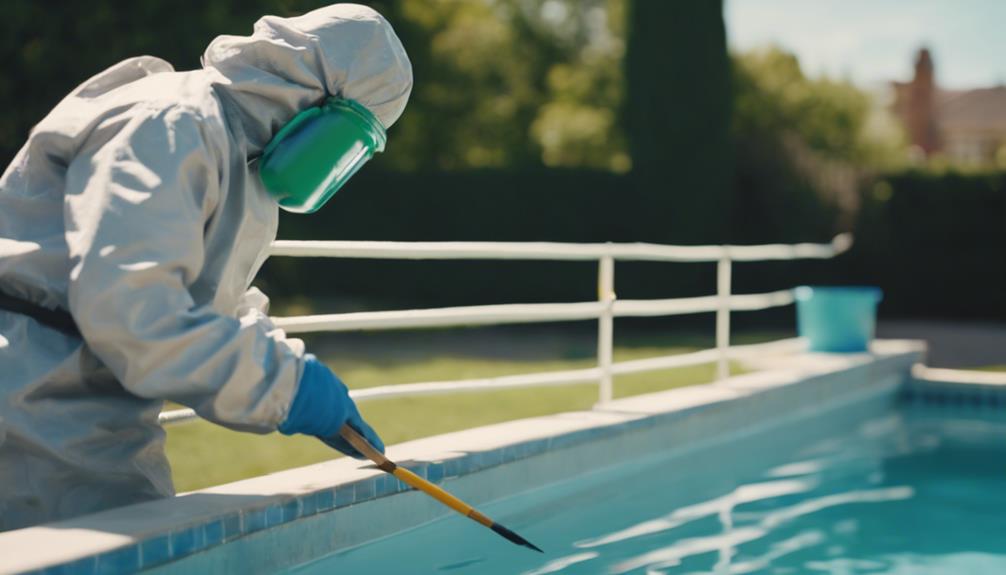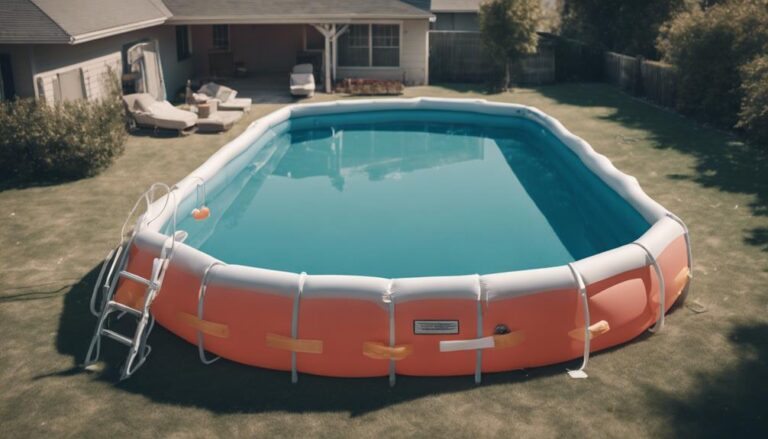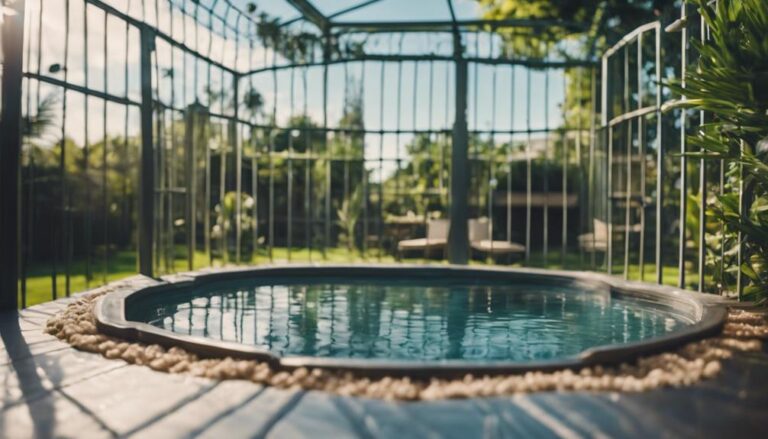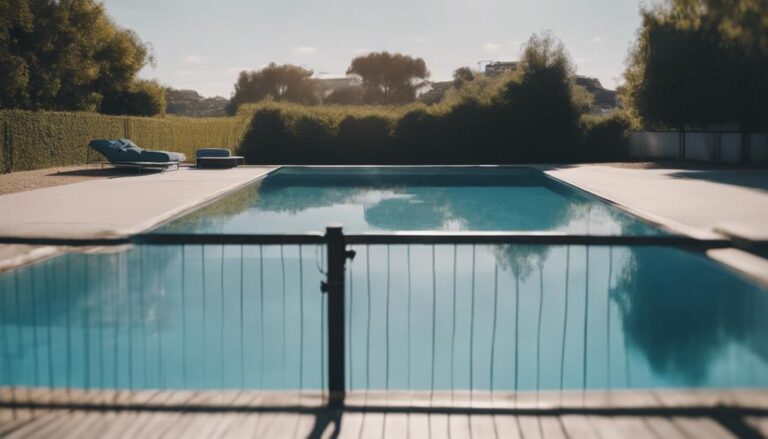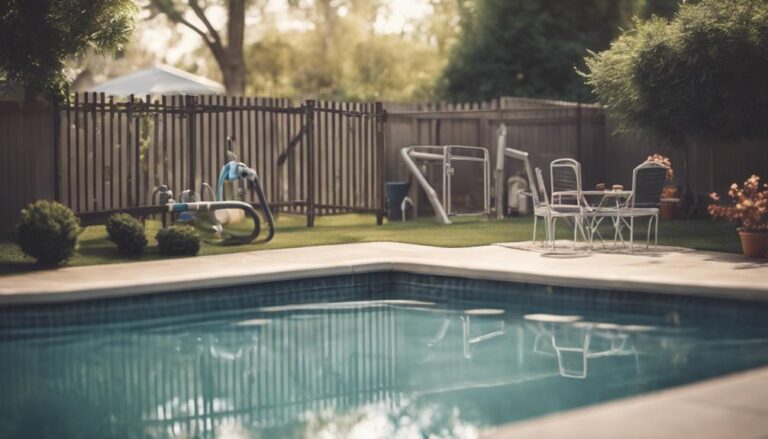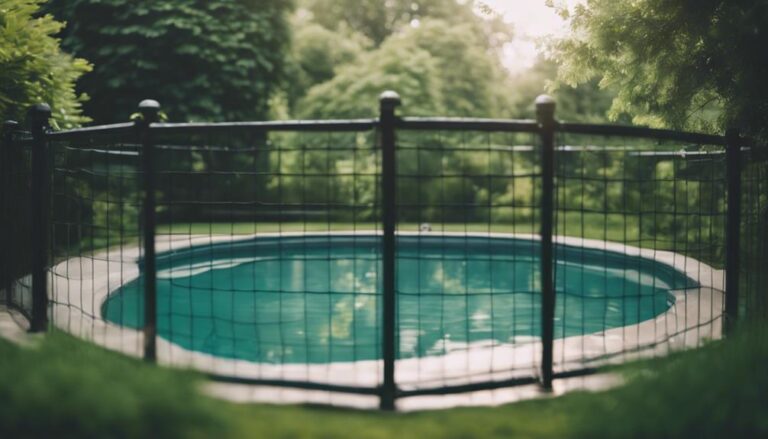How to Paint Pool Fence
To paint your pool fence, start by thoroughly cleaning the surface to remove any dirt, dust, and grease. Apply a rust-inhibiting primer, especially if your fence is made of aluminium, to create a clean base. When choosing paint, opt for an oil-based Rust-Oleum product for its corrosion resistance. Select a gloss black topcoat for a stylish, long-lasting finish. Use an HVLP sprayer for an even coverage, and make sure to wear protective gear like goggles and gloves for safety.
Keep your fence well-maintained by regularly touching up any scratches or chips to maintain its appearance. Following these steps will ensure a professional and durable finish.
Preparing the Surface
Before starting your pool fence painting project, it's crucial to thoroughly clean the surface by removing all dirt, dust, and grease to ensure the paint sticks well. This first step is essential in preparing the surface, laying the foundation for a long-lasting and protective finish. Paying close attention during the cleaning process is vital, as even small impurities can impact the quality of your paint job.
Once the pool fence is clean and completely dry, the next step is to apply a primer that is specifically designed for aluminium surfaces. This is important because the primer acts as a bonding agent between the metal and the paint, enhancing the durability of the finish. Choosing the right primer is just as crucial as selecting the correct paint, as it plays a significant role in the longevity and protection of the fence.
Proper preparation doesn't stop at cleaning and priming; it also involves ensuring that the surface is free from any impurities before painting. This thorough approach guarantees that the paint job will not only look professional but will also last over time, shielding your pool fence from the elements and maintaining its visual appeal.
Choosing the Correct Paint
Having prepared your pool fence with a thorough cleaning and the application of a suitable primer, it is now essential to focus on selecting the appropriate paint to ensure the longevity and aesthetic appeal of your project. Opting for an oil-based Rust-Oleum paint is a wise decision, especially for its corrosion-resistant properties, which are vital for a pool fence exposed to moisture and chemicals.
Before applying your top coat, it is crucial to apply a rust-inhibiting primer. This primer ensures proper adhesion of the paint to the fence, creating a strong foundation that enhances the durability of your paint job. For the top layer, an industrial coating is recommended. This type of paint provides durability and long-lasting protection against the elements, ensuring that your pool fence remains in excellent condition for years to come.
For a sleek and polished appearance, choose a gloss black top coat. This colour not only adds a contemporary touch to your pool area but also offers a surface that is easier to clean and maintain. Finally, the importance of using Crud Cutter for cleaning and degreasing the fence before painting cannot be overstated. This step is essential for improving adhesion and achieving a professional finish.
Rust Prevention Techniques
To effectively prevent rust and ensure the longevity of your pool fence, carrying out regular inspections for any signs of corrosion or damage is vital. Early detection of rust spots and their swift treatment is a crucial step in maintaining the structural integrity of your pool fence. During inspections, pay close attention to any damage that could accelerate corrosion, particularly in areas that are hard to access.
Upon discovering flaking paint or rust, it is essential to remove these with a wire brush before proceeding with any protective measures. This preparation ensures that the surface is clean and ready for a rust-inhibitive primer, acting as a barrier against further rust formation. Specialised primers for hard-to-reach spots are available, guaranteeing comprehensive rust prevention throughout the entire fence.
Dealing with rust spots as soon as they are noticed prevents their spread and further damage. In cases where the damage is substantial, replacing sections of the fencing may be necessary to eliminate safety risks. Regular maintenance and immediate action are your most effective defences against corrosion, ensuring your pool fence remains secure and visually pleasing for many years.
Applying Primer Correctly
Before you start applying primer to your aluminium pool fence, it's crucial to select the right type. A rust-inhibitive primer that's compatible with your topcoat paint will ensure the best protection against corrosion and enhance paint adhesion.
Proper application techniques, including a thorough cleaning of the surface and even primer distribution, lay the groundwork for a durable and smooth finish.
Selecting the Right Primer
Selecting a rust-preventive primer specifically designed for metal surfaces such as aluminium pool fences is critical for ensuring both adhesion and the longevity of the paintwork. It is necessary to choose a primer that is compatible with aluminium to support not only adhesion but also to offer corrosion resistance. This step safeguards your pool fence against rust and other damages, playing a key role in the durability of the paint.
| Key Feature | Importance | Benefit |
|---|---|---|
| Rust-preventive | Prevents corrosion | Extends fence life |
| Aluminium-compatible | Ensures proper adhesion | Smooth, durable finish |
| Corrosion resistance | Shields from damage | Maintains aesthetic appeal |
Choosing the appropriate primer for aluminium surfaces is imperative for both the adhesion process and the paint's longevity, ensuring the pool fence remains protected from rust and other forms of damage. This contributes significantly to the durability and aesthetic appeal of the fence.
Primer Application Techniques
Applying a rust-preventative primer designed for metal surfaces necessitates an even and generous coating on your pool fence to ensure optimal adherence. This step is pivotal in the primer application process as it establishes the foundation for a durable and effective paint job.
To prevent rust formation, pay particular attention to hard-to-reach spots and corners where moisture can accumulate. These areas are prone to corrosion if not properly sealed with primer.
After application, allowing the primer to dry thoroughly before proceeding to the topcoat is critical. This patience ensures that the primer bonds securely to the metal surfaces, improving the adherence of the subsequent paint layers.
Properly applied, a quality rust-preventative primer significantly contributes to the longevity of your pool fence's paint job, protecting it against the elements.
Techniques for Even Coating
To achieve a uniform coating and smooth finish on your pool fence, it's advisable to use an HVLP sprayer. This tool is essential for applying paint with precision, minimising waste, and ensuring your fence receives a consistent layer of paint. Before you start, adjusting the spray patterns of your HVLP sprayer is crucial. This adjustment helps to control overspray and makes it easier to achieve a uniform coating across the entire surface.
Before applying your semi-gloss industrial coating, the fence must be properly prepared. Cleaning and degreasing the surface are vital steps in this process. Any dirt, oil, or grime can prevent the paint from sticking correctly, leading to an uneven finish. If you encounter rusty areas, spot priming them before applying the topcoat is a wise decision. This technique ensures that the affected areas are well protected and that the final coating looks consistent and smooth.
Using these techniques when using your HVLP sprayer will not only provide a uniform coating but also extend the durability of your paint job. A well-prepared surface, combined with the correct application method, is the key to achieving a professional-grade finish on your pool fence.
Touch-Up Maintenance Tips
After ensuring your pool fence has a consistent coating, it's vital to conduct regular inspections for any areas that might require touch-up maintenance to preserve its optimal condition. Over time, exposure to weather conditions can result in chipped or scratched surfaces on your pool fence. Addressing these defects swiftly is essential in maintaining both the aesthetic appeal and structural integrity of the fence.
For touch-up maintenance, it's paramount to utilise the same type of paint that was initially applied to the pool fence. This ensures uniformity in colour and finish, preventing any noticeable discrepancies. Prior to applying the paint, cleanse the affected area with mild soap and water. This step is crucial for ensuring the touch-up paint adheres properly to the fence surface.
When applying the touch-up paint, ensure it's done evenly and smoothly to integrate it seamlessly with the surrounding areas. This meticulous application avoids making the touch-up obvious and maintains the overall cohesive appearance of the fence.
Safety and Clean-Up Procedures
Before starting your pool fence painting project, it's crucial to prioritise your safety by wearing protective gear, including goggles, gloves, and a mask, to shield yourself from harmful chemicals.
Ensure a thorough clean-up by using drop cloths to protect the surrounding area from paint spills and disposing of paint materials according to local regulations.
Adopting these safety gear essentials, effective clean-up steps, and hazard prevention techniques won't only streamline your painting process but also safeguard your health and the environment.
Safety Equipment Essentials
Ensuring your safety while painting a pool fence is of utmost importance; therefore, it is essential to equip yourself with protective gear. This includes protective goggles to shield your eyes from paint splatters and fumes, a respirator mask to prevent the inhalation of hazardous chemicals, gloves to protect your hands from paint and chemicals, and clothing that fully covers your skin to ensure no skin is exposed to irritants. Adequate ventilation is also crucial to avoid breathing in harmful fumes. Below is a detailed list of essential safety gear:
- Protective Goggles: Protect your eyes from paint splatters and fumes.
- Respirator Mask: Prevent the inhalation of hazardous chemicals.
- Gloves: Protect your hands from paint and chemicals.
- Covered Clothing: Ensure that no skin is exposed to irritants.
Effective Clean-Up Steps
Why is it necessary to adhere to effective clean-up procedures after painting your pool fence? Proper clean-up prevents environmental damage and ensures safety. Dispose of paint materials correctly by following local regulations, thus protecting our planet.
Immediate cleaning of any spilt paint prevents potential accidents, maintaining a safe work area. Always wear protective gear, such as gloves and masks, during clean-up to shield yourself from harmful chemicals.
Store leftover paint in a secure, dry location, out of reach of children and animals, to avoid any mishaps. Correct disposal of paint and cleaning supplies not only abides by the law but also safeguards your health and the environment.
These steps are crucial for a successful and responsible painting project.
Hazard Prevention Techniques
Having examined the significance of effective clean-up procedures, our attention now turns to hazard prevention techniques to uphold safety and cleanliness during your pool fence painting project. Implementing these strategies guarantees a safer environment for all participants.
- Wear Protective Equipment: It's vital to equip oneself with gloves, goggles, and a mask to protect against harmful fumes and chemicals. This is essential for your health while applying paint near your pool fence.
- Utilise Drop Cloths: Deploy drop cloths or old blankets beneath the painting area to capture any drips or spills, thus avoiding stains on your deck or landscaping.
- Dispose of Paint Appropriately: Adhere to local environmental regulations for the disposal of paint materials to prevent ecological damage.
- Ensure the Area is Secure: Maintain a safe distance for children and animals from the painting area to prevent accidental exposure to paint and chemicals. Promptly cleaning up spills reduces the risk of slips and falls, especially around wet areas.
Frequently Asked Questions
What is the best way to paint a pool fence?
To paint your pool fence effectively, make sure to clean it thoroughly, use a primer specifically for metal surfaces, select high-quality metal paint, apply it evenly with a sprayer, and think about adding a clear coat for additional protection and durability.
Can I paint an aluminium fence?
Yes, you can paint an aluminium fence, but it's important to properly prepare the surface and use the correct type of paint to ensure adhesion and durability over the powder-coated finish.
How do you prepare a metal fence for painting?
To prepare a metal fence for painting, you'll first clean it to remove dirt and grease. Then, use a wire brush on rust and flaking paint, apply a rust-inhibitive primer, and sand it smooth.
What is the simplest way to paint a fence?
To easily paint a fence, start by thoroughly cleaning it. Smooth the surface with sandpaper, apply a suitable undercoat, and use a paint sprayer for efficient and even coverage. Choose a long-lasting exterior paint for durability.
